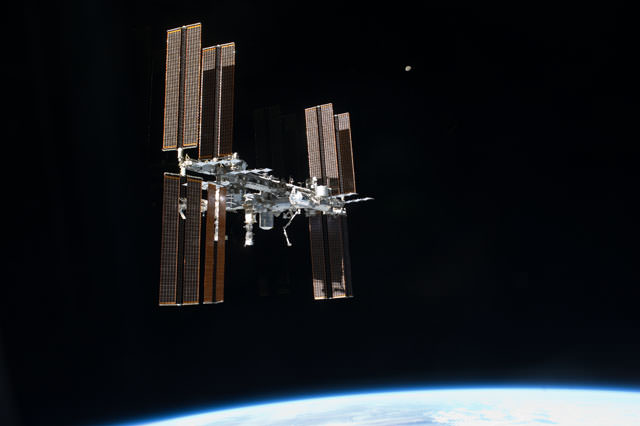[/caption]
Russia and ESA are just finishing up a 500-day simulated Mars mission here on Earth, and now Roscosmos, Russia’s Federal Space Agency is considering taking it to the next level and conducting a “virtual” Mars mission experiment in space, on board the International Space Station. This tentative plan would have two cosmonauts and/or astronauts staying on board the ISS for up to 18 months, matching the potential length of a manned Mars mission.
“We are interested in staging such an experiment in actual conditions of zero gravity,” Roscosmos’ deputy head Vitaly Davydov told Itar-Tass. While there are so specific plans at this time, Davydov added that such a project might be possible after 2014, since the schedule of ISS work and its crews for the next two years have already been plotted.
As of now, crews on the space station usually stay no longer than 6 months, to avoid long-term bone and muscle mass loss, as well as keeping the crews “fresh.” Davydov said Russia cannot make such a decision unilaterally, and would have to get consent from other international partners in the program.
The major issues in doing this would be how the costs would be divided by the 16 countries involved the ISS program and which countries the astronauts would be from. If such a mission would be approved, it will be interesting to see how much interest there is by astronaut and cosmonaut corps for staying in space for 18 months.
Source: Itar-Tass


From what I gather a lot of people consider the science done aboard the ISS to be of little value, or not worth the expense against using an automated system. (probably a gross generalisation)
This however would seem to be a perfect use for the ISS. A relatively safe and proven method of putting a crew into a zero-g environment for extended periods, but with the ability to quickly retrieve them should there be an emergency.
My first questions would be how to do this from a logistics point of view. Do you truck up a bunch of x-nauts and supplies, then basically abandon them aboard the ISS for 18 months? Do you cordon off a section of the ISS purely for this experiment and leave the rest of the ISS open for normal operations?
Definitely interested to see how this pans out.
This sounds like a great experiment but I feel like it would take a great chunk of research capacity from the ISS. Also, as Slugsie mentioned in a post below, there’s a logistics issue of how resupply missions will affect the experiment, and how the presence of changing crews will affect the astronauts in this mission.
I imagine this could possibly done with a couple of Bigelow modules, this has the advantage in that a larger crew (5-6) can be supported and that the crew can be completely isolated for a period of 18-24 months. Might be more expensive than just simply using the ISS but you can then control your experiment conditions way better.
I’d also really love to see a large scale Aeroponics demonstration project to test the issues associated with space farming and a crew’s ability to sustain themselves with it. These are areas where NASA should be pumping more money now that the Shuttle budget has freed up.
The idea of using Bigelow module also has the advantage of testing these modules and the system onboard for a long duration flight.
You could look at the logistics and see if it was feasable to have all supplies onboard or if you needed to pre-deploy equipment to Mars orbit.
The other issue is the different radiation environment between Deep Space and LEO so consideration could be given to an un-manned test flight of key components that also carry out other science objectives such as the proposed Red Dragon.
The trouble with using the shuttle money is that Congress has already spent it on SLS and MPCV.
Yes they should also do radiation shielding research. Not all the money proposed for SLS has been spent yet ofcourse because it’s a yearly budget. The sooner they end that program the better but unfortunately I doubt that’ll happen soon.
They want to build heavy launch vehicles for deep-space missions without even fully and thoroughly completing the necessary research required for life support and radiation shielding etc. Its just depressing.
I think using a Bigelow module is a great idea. I wonder if there could be a rotating centrifuge added some how? I am suprised that this technology has not been tried yet unless it is beyond our capabilities or is cost prohibitive?
I think using a Bigelow module is a great idea. I wonder if there could be a rotating centrifuge added some how? I am suprised that this technology has not been tried yet unless it is beyond our capabilities or is cost prohibitive?
I think using a Bigelow module is a great idea. I wonder if there could be a rotating centrifuge added some how? I am suprised that this technology has not been tried yet unless it is beyond our capabilities or is cost prohibitive?